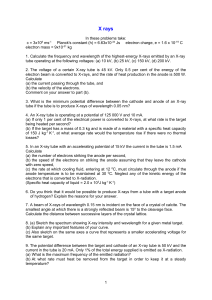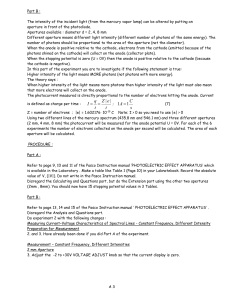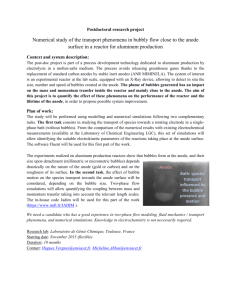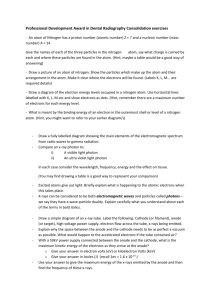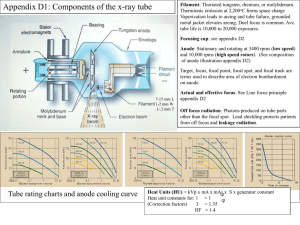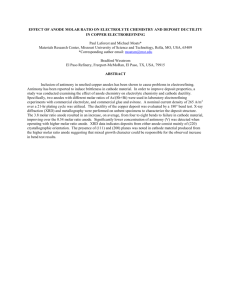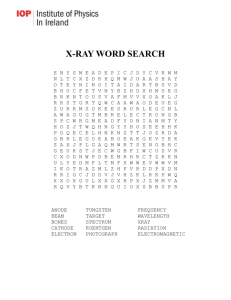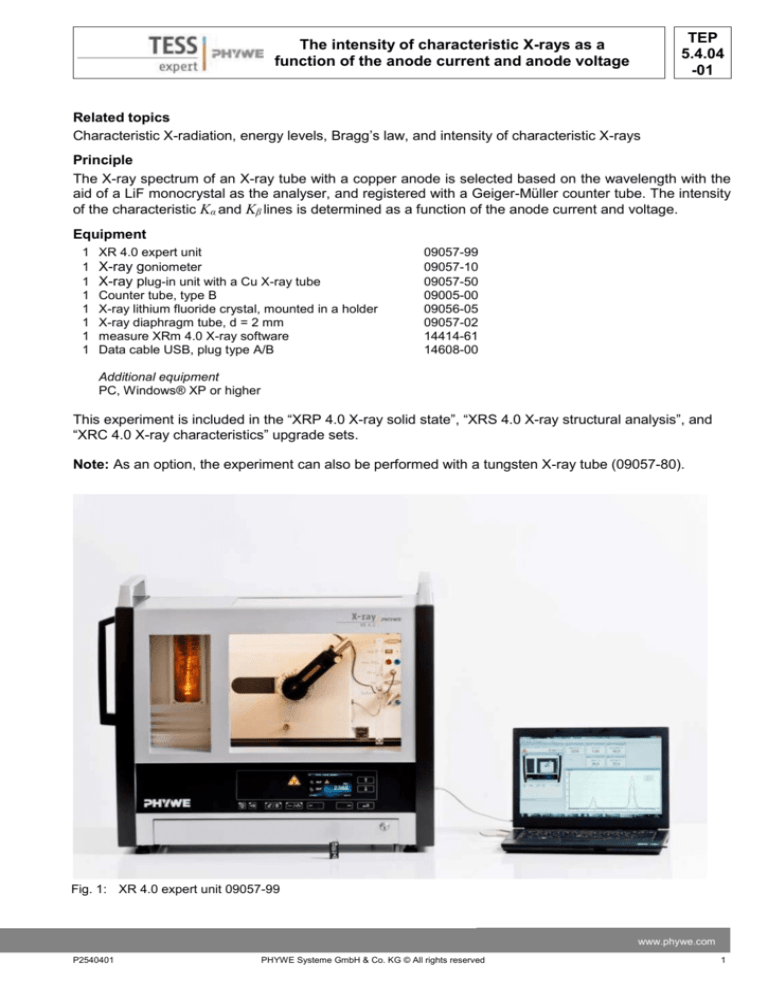
TEP
5.4.04
-01
The intensity of characteristic X-rays as a
function of the anode current and anode voltage
Related topics
Characteristic X-radiation, energy levels, Bragg’s law, and intensity of characteristic X-rays
Principle
The X-ray spectrum of an X-ray tube with a copper anode is selected based on the wavelength with the
aid of a LiF monocrystal as the analyser, and registered with a Geiger-Müller counter tube. The intensity
of the characteristic Kα and Kβ lines is determined as a function of the anode current and voltage.
Equipment
1
1
1
1
1
1
1
1
XR 4.0 expert unit
X-ray goniometer
X-ray plug-in unit with a Cu X-ray tube
Counter tube, type B
X-ray lithium fluoride crystal, mounted in a holder
X-ray diaphragm tube, d = 2 mm
measure XRm 4.0 X-ray software
Data cable USB, plug type A/B
09057-99
09057-10
09057-50
09005-00
09056-05
09057-02
14414-61
14608-00
Additional equipment
PC, Windows® XP or higher
This experiment is included in the “XRP 4.0 X-ray solid state”, “XRS 4.0 X-ray structural analysis”, and
“XRC 4.0 X-ray characteristics” upgrade sets.
Note: As an option, the experiment can also be performed with a tungsten X-ray tube (09057-80).
Fig. 1: XR 4.0 expert unit 09057-99
www.phywe.com
P2540401
PHYWE Systeme GmbH & Co. KG © All rights reserved
1
TEP
5.4.04
-01
The intensity of characteristic X-rays as a
function of the anode current and anode voltage
Tasks
1. Analyse the intensity of the X-radiation as a function of the
Bragg angle and with the aid of a LiF monocrystal.
2. Determine the intensity of the characteristic X-ray lines as a
function of the anode voltage and current.
3. Compare the results of the experiment to the results that can
be expected theoretically.
The parameters for the experiment with a tungsten tube are
shown in the appendix.
Set-up
Connect the goniometer and the Geiger-Müller counter tube to
their respective sockets in the experiment chamber (see the red
markings in Fig. 2). The goniometer block with the analyser crystal should be located at the end position on the right-hand side.
Fasten the Geiger-Müller counter tube with its holder to the back
stop of the guide rails. Do not forget to install the diaphragm in
front of the counter tube (see Fig. 3).
Insert a diaphragm tube with a diameter of 2 mm into the beam
Fig. 2: Connectors in the experiment
outlet of the tube plug-in unit for the collimation of the X-ray
chamber
beam.
For calibration: Make sure, that the correct crystal is entered in
the goniometer parameters. Then, select “Menu”, “Goniometer”, “Autocalibration”. The device now determines the optimal positions of the crystal and the goniometer to each other and then the positions of
the peaks.
GM-counter
tube
Goniometer at
the end position
Diaphragm tube
Counter tube
diaphragm
Mounted
crystal
Fig. 3: Set-up of the goniometer
2
PHYWE Systeme GmbH & Co. KG © All rights reserved
P2540401
The intensity of characteristic X-rays as a
function of the anode current and anode voltage
TEP
5.4.04
-01
Note
Details concerning the operation of the X-ray unit
and goniometer as well as information on how to
handle the monocrystals can be found in the respective operating instructions.
Procedure
- Connect the X-ray unit via USB cable to the
USB port of your computer (the correct port of
the X-ray unit is marked in Fig. 4).
- Start the “measure” program. A virtual X-ray
unit will be displayed on the screen.
- You can control the X-ray unit by clicking the
various features on and under the virtual X-ray
unit. Alternatively, you can also change the parameters at the real X-ray unit. The program will
automatically adopt the settings.
Fig. 4: Connection of the computer
Task 1: Analyse the intensity of the X-radiation as
a function of the Bragg angle and with the aid of a
LiF monocrystal.
For setting the
For setting the
Click the experiment chamber (see the red
X-ray tube
goniometer
marking in Figure 5) to change the parameters
for the experiment. Select the parameters as
shown in Figure 6 (scanning range: 4°-55°).
- If you click the X-ray tube, you can change the
voltage and current of the X-ray tube. Select the
following
parameters:
anode
voltage
Fig. 5: Part of the user interface of the software
UA = 35 kV; anode current IA = 1 mA.
- Start the measurement by clicking the red circle
-
-
After the measurement, the following window
appears:
-
Select the first item and confirm by clicking
Fig 6: Settings of the goniometer; LiF crystal
OK. The measured values will now be transferred directly to the “measure” software.
At the end of this manual, you will find a brief introduction to the evaluation of the resulting spectra.
-
www.phywe.com
P2540401
PHYWE Systeme GmbH & Co. KG © All rights reserved
3
TEP
5.4.04
-01
The intensity of characteristic X-rays as a
function of the anode current and anode voltage
Task 2: Determine the intensity of the characteristic
X-ray lines Kα and Kβ of copper as a function the anode voltage and current.
- Click the experiment chamber (see the red marking in Figure 5) in order to change the parameters
for the experiment. Select a scanning range of
19°-24°.
- If you want to determine the dependence of the
intensity on the anode current, record a spectrum
with various different anode currents. Settings: UA
= 35 kV = const.; IA = 1 mA...0.1 mA in steps of
0.1 mA.
- If you want to determine the dependence of the
intensity on the anode voltage, record a spectrum
with various different anode voltages. Settings:: IA
= 1 mA = const.; UA = 35 kV...11 kV in steps of 2-3
kV.
- The evaluation is the same as for task 1.
Note: Never expose the Geiger-Müller counter tube
to the primary X-radiation for an extended period of
time.
Overview of the settings of the goniometer
and X-ray unit:
- 2:1 coupling mode
- Gate time: 2 s; angle step width: 0.1°
For recording a complete spectrum:
- Scanning range: 4°-55°
- Anode voltage: UA = 35 kV;
anode current: IA = 1 mA
For determining the intensity of the characteristic lines as a function of UA and IA:
- Scanning range: 19°-24°
- UA = 35 kV = constant; IA = 1 mA...0.1 mA
in steps of 0.1 mA
- IA = 1 mA = constant; UA = 35 kV...11 kV
in steps of 2-3 kV
Detailed information concerning the operation of the software can be found in the
handbook and in the Help of the software.
Theory
The electrons coming from the cathode are accelerated towards the anode by the voltage UA between
the cathode and anode. Due to the resulting high level of kinetic energy, the electrons are capable of
ejecting electrons from the inner shells of the atoms of the anode material. If this occurs on the K shell of
the atoms, an electron from a higher shell, e.g. the L or M shell, can take up the free place while emitting
an X-ray quantum. The energy of this X-ray quantum corresponds to the energy difference of the two
shells that are involved in this process. Since this energy difference is atom-specific, the resulting radiation is also called characteristic X-radiation. X-radiation that is produced following a transition from the L
shell to the K shell is called Kα radiation, while the radiation that is produced following a transition from
the M shell to the K shell is called Kβ radiation.
The intensity IK of the K radiation is:
I K B I A U A U K
1.5
(1)
(IA = anode current, UA= anode voltage, B = const. and UK = ionisation potential of
the K shell)
The depth of penetration of the ionising electrons into the anode material as well as the escape depth of
the generated X-rays is limited. When they have both reached their maximum, the relationship given in
(1) loses its validity.
With the aid of Bragg’s law:
2d sin n
n 1, 2, 3,...
(2)
and the known interplanar spacing of the LiF crystal (d = 201.4 pm), the wavelength λ of the characteristic Kα and Kβ lines can be calculated based on the glancing angles ϑ that were determined experimentally. Based on the relations c = λ・f (velocity of light c = 2.9979・108 m/s), the frequency f of the lines
can be calculated. Then, E = h・f finally leads to the energy E of the lines (Planck's constant
4
PHYWE Systeme GmbH & Co. KG © All rights reserved
P2540401
TEP
5.4.04
-01
The intensity of characteristic X-rays as a
function of the anode current and anode voltage
h = 6.626・10-34Js).
E
n h c
2d sin
(3)
n =1
n=2
ϑ/°
λ/pm
ϑ/°
λ/pm
Cu (Z=29)Kα
22.6
154.8
50.2
154.7
Cu (Z=29)Kβ
20.4
140.4
43.9
139.6
Evaluation and results
In the following section, the evaluation of the data is
described based on example results. Your results
may differ from the results given below. The evaluaFig. 7: X-ray spectrum of copper, LiF monocrystal as
tion of the results that were obtained with the tungthe analyser
sten tube is described in the appendix.
Task 1: Analyse the intensity of the X-radiation of
copper as a function of the Bragg angle and with the
aid of a LiF monocrystal.
Figure 7 shows the X-ray spectrum of copper up to
the second-order interference. The table shows the
resulting glancing angles ϑ of the characteristic lines
as well as the corresponding wavelengths that were
calculated based on (2).
Task 2: Determine the intensity of the characteristic
X-ray lines of copper Kα and Kβ as a function of the
anode voltage and current.
Intensity as a function of the anode voltage
Fig. 8: Scanning range 19° < ϑ < 24° at different anode
Figure 8 shows the relevant scanning range with the
voltages
pulse rates for various different selected anode voltages.
In Figure 9, the lower curves show the measured intensity (pulse rate) of the characteristic lines (intensity maximum of the lines) as a function of the anode current IA at a constant anode voltage UA = 35 kV.
However, excessively high pulse rates cause the Geiger-Müller counter tube to become saturated. The
deviation of the measurement curves from the expected linearity can be eliminated by taking the dead
time of the Geiger-Müller counter tube into consideration at high pulse rate values. These corrected values are represented by the upper curves in Figure 9.
If τ (τ ≈ 90 μs) is the dead time of the Geiger-Müller counter tube and N0 is the measured pulse rate, the
www.phywe.com
P2540401
PHYWE Systeme GmbH & Co. KG © All rights reserved
5
TEP
5.4.04
-01
The intensity of characteristic X-rays as a
function of the anode current and anode voltage
true pulse rate N is:
N
N0
1 N0
(3)
Kα
Intensity as a function of the anode current
Figure 10 shows the relevant scanning range with the
pulse rates for various different selected anode currents.
Figure 11 shows the intensity course of the two characteristic lines as a function of the anode voltage UA (IA=
const. = 1 mA). The lower curves represent the measured pulse rates while the upper curves show the pulse
rates that were corrected in terms of the dead time of
the Geiger-Müller counter tube.
Kβ
Fig. 9: Intensity of the Kα and Kβ lines (n = 1) as
a function of the anode current IA
Task 3: Compare the results of the experiment to the
results that can be expected theoretically.
If the experimental results are compared to the results
that can be expected theoretically, the linear relationship
between UA - UK and the pulse rate of (1) is confirmed. If
one plots the true pulse rates of the characteristic lines
of Figure 12 as a function of (UA-UK)1.5 (with UK = 8.979
keV for copper, see the experiment P2540101), a
straight line results.
Fig. 10: Scanning range 19° < ϑ < 24° at different anode
voltages
Kα
Kα
Kα
KβKβ
Kβ
(𝑈𝐴 − 𝑈𝐾 )3⁄2
Fig. 11: Intensity of the Kα and Kβ lines (n = 1) as a function
𝑘𝑉 3⁄2
of the anode voltage UA
Fig. 12: The true pulse rates of the Kα and Kβ lines as a
function of (UA-UK)1.5; (IA = const. = 1 mA)
6
PHYWE Systeme GmbH & Co. KG © All rights reserved
P2540401
The intensity of characteristic X-rays as a
function of the anode current and anode voltage
TEP
5.4.04
-01
“measure” software
With the “measure” software, the peaks in the spectrum can be determined rather easily:
-
-
Click the button
and select the area for the peak determination.
Click the button
“Peak analysis”.
Refer to the Help of the
“measure” software for addiThe window “Peak analysis” appears (see Fig. 13).
tional, more detailed explanaThen, click “Calculate”.
tions concerning the program
If not all of the desired peaks (or too many of them) are calfeatures.
culated, readjust the error tolerance accordingly.
Select “Visualise results” in order to display the peak data directly in the spectrum.
Fig. 12: Automatic peak analysis with “measure”
www.phywe.com
P2540401
PHYWE Systeme GmbH & Co. KG © All rights reserved
7
TEP
5.4.04
-01
The intensity of characteristic X-rays as a
function of the anode current and anode voltage
Appendix
Overview of the settings of the goniometer and X-ray unit:
- 2:1 coupling mode
- Gate time 5-6 s; angle step width 0.1°
- Scanning range 4°-80° (LiF monocrystal)
- Anode voltage UA = 35 kV; anode current
IA = 1 mA
Procedure using a tungsten tube:
Task 1: Record the entire spectrum:
See P2542801 for the evaluation of the spectrum.
Task 2: Determine the intensity of a single line
For the evaluation, examine the lines α1 and α2 that
appear as one single line.
The following settings are recommended:
Determination of the intensity of the characteristic lines as a function of UA and IA:
Gate time 3s
Scanning range: 4°-25°
UA = 35 kV = const. ; IA = 1 mA...0.1 mA in
steps of 0.1 mA
IA = 1 mA = const. ; UA = 35 kV...11 kV in
steps of 2-3 kV
Theory and evaluation
Since the energy of the K shell is approximately 70 keV, the maximum available energy of the primary
beam of the X-ray unit of 35 keV is insufficient for exciting the K shell. Only the L level can be ionised.
P2542802 includes the corresponding energy-level-diagram.
For the evaluation, the lines α1 and α2 are examined. They result from the L3M5/L3M4 transition. These two
lines are so close to each other that they cannot be
separated but rather appear as a single line.
The evaluation follows that of copper, but in this
case with only one single line. For task 3, the ionisation potential of the L3 shell UK = 10.206 keV is
used since the transition takes place to this shell
(see the energy-level-diagram of tungsten in
P2542801).
Fig 14: Scanning range 4° < ϑ < 25° at different anode
voltages for the tungsten tube
8
PHYWE Systeme GmbH & Co. KG © All rights reserved
P2540401

